Ijraset Journal For Research in Applied Science and Engineering Technology
- Home / Ijraset
- On This Page
- Abstract
- Introduction
- Conclusion
- References
- Copyright
The Intersection of Comprehension Skills and Critical Thinking: A Quantitative Analysis of Research Output
Authors: Sahaya Restina James, Dr. K Selvam
DOI Link: https://doi.org/10.22214/ijraset.2024.64271
Certificate: View Certificate
Abstract
Purpose: This study examines the relationship between reading comprehension and critical thinking skills through a systematic review of existing literature. Reading comprehension and critical thinking are recognized as fundamental abilities for academic and career success. However, research often treats them as separate constructs despite their interconnectedness. This review synthesizes qualitative findings across multiple sectors to understand the applicability of comprehension skills and their connection to critical thinking. Methodology: A search on the Scopus database yielded 2298 relevant studies after screening, from which a final sample of 225 studies was analyzed. Bibliometric visualizations highlight critical thinking as the central focus, with reading comprehension, argumentation, problem-solving, and critical reading emerging as closely linked components. The overlay visualization suggests a research emphasis shift from critical reading to problem-solving skills over time. The density visualization indicates critical thinking received the highest priority, followed by reading comprehension and critical thinking skills. Findings/Implications: Key gaps identified include limited research integrating both skills for English language learners, lack of long-term intervention studies, and overlooked factors like motivation and technology. The findings underscore the crucial role of strong comprehension abilities, particularly critical reading and problem comprehension, as building blocks for developing critical thinking proficiency. Future research should explore innovative pedagogical approaches to seamlessly cultivate these interconnected skills among diverse learner populations.
Introduction
I. INTRODUCTION
Reading comprehension and Critical thinking are the key skills that foster the capability of a learner to connect or transfer the classroom learning into workspace. Various studies have brought out the connection of these fundamental skills playing a major role in building the career of individuals. Critical thinking skills, vocabulary, and cognitive abilities in understanding and improving reading comprehension are basic skills for college students. Also, it is stated in studies that interventions targeting these areas could potentially enhance students' reading comprehension skills, thereby aiding their academic success. (Farley and Elmore)
Moreover, active learning occurs within an environment where individuals have the freedom to act, fostering opportunities for the development of integrated critical thinking and language abilities. Critical thinking, characterized by advanced cognitive processes, enables learners to in critical analysis using problem-solving approaches.(Almulla and Al-Rahmi) Similarly, reading, viewed as a form of problem-solving, requires learners to possess strong cognitive skills. Creative thinking sprouts from the above said cognitive skills, a study emphasizes the interconnectedness of various cognitive skills with reading comprehension, offering insights into potential strategies for educational improvement and assessment refinement.
From the above we can see that critical thinking and reading comprehension have been a variable of study from past few decades. It thus highlights the importance of these skills, especially reading where fostering active reading strategies among undergraduates paves way to enhance their learning experience and suggest that educators should implement training programs to facilitate this engagement, ultimately benefiting students’ academic progress.(Zepke and Leach)
The realization of the importance of reading comprehension dates from the past four to five decades, studies indicate that this skill is a thread line for all the domains, area of specialization and across fields.
However, comprehension skills do not restrict to one’s understanding of what one reads, there are other channels through which one receives information for comprehension, such as listening, observing the environment and what happens around them. Understanding or inferring that information also features under comprehension skills.
This study is thus aimed at reviewing the existing studies and carrying out a qualitative synthesis across different sectors to understand the applicability of comprehension skills and their connectedness with critical thinking.
II. METHODOLOGY
A bibliometric analysis was conducted, adapting the search strategy including keywords reading comprehension and critical thinking. Bibliometric analysis is a comprehensive way of analyzing the large volume of scientific data and finding the research gaps. (Donthu et al.). Bibliometric analysis is thus used to find the research gap and the trends of the publication in the selected keywords. (Murali and Mohamed Jasim). The analysis was carried out using the Bibliometrix tool provided by (Aria and Cuccurullo). Using the Vos viewer proposed by (Van Eck and Waltman) keyword analysis was done, and the cluster table was generated.
Table 1 Keywords used in the Scopus Search
|
Field |
Description |
|
TITLE-ABS-KEY |
Searches for the specified keywords in the title, abstract, and keywords of the articles. |
|
( "Critical Thinking" OR "Analytical Skills" ) |
Looks for articles containing either "Critical Thinking" or "Analytical Skills" in their title, abstract, or keywords. |
|
AND |
Specifies that all conditions must be met. |
|
( "Reading Comprehension" ) |
Requires articles to also mention "Reading Comprehension". |
|
( LIMIT-TO ( SUBJAREA , "SOCI" ) ) |
Limits the search to articles categorized under the subject area "SOCI" (Sociology). |
|
( LIMIT-TO ( DOCTYPE , "ar" ) ) |
Filters results to include only articles (DOCTYPE: article). |
|
( LIMIT-TO ( SRCTYPE , "j" ) ) |
Specifies that the articles must come from journals (SRCTYPE: journal). |
|
( LIMIT-TO ( LANGUAGE , "English" ) ) |
Filters the results to include only articles published in English. |
|
( LIMIT-TO ( OA , "all" ) ) |
Ensures that articles with any access type (open access or otherwise) are included. |
The studies included had either reading comprehension or critical thinking as a determinant or a dependent variable. The studies conducted in English domain is included in predominant number similarly studies pertaining to other sectors like engineering, maths, science and medicine is also included in minimal to indicate the inclusive nature of the skill. The results of the analysis of the research on reading comprehension and critical thinking in the studies were included and the extraction of bibliographic data was led by a data collection chart. The bibliographic material included study goals and procedures, as well as details about who was involved, why and where the study was conducted, and how the data were gathered and processed.
The databases Scopus predominantly yielded a total of 2346 records, of which 48 duplicates were eliminated. 2298 studies made it beyond the title and abstract screening stage and were retained for full-text evaluation. 1505 studies that didn't fit our inclusion criteria—being pertinent to the keywords—were not taken in the full-text reviews. Of the 793 records, 585 were then further eliminated because they were not conceptualized, 259 because they were not relevant to the current area of study, 201 because of language barriers (non-English publications), and 58 because they were not properly interpreted. As a result, our systematic review's ultimate sample size was 225 (figure 1).(Page et al.)

Figure 1 PRISMA framework for filtering the “Reading Comprehension” and “Critical Thinking” works in the Scopus
III. DATA ANALYSIS
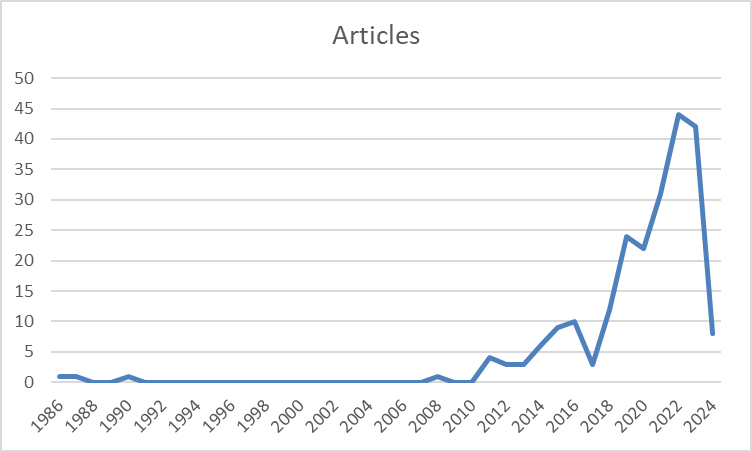
Figure 2 Year Wise publication of Articles
The x-axis of the graph lists years, ranging from 1986 to 2024. The y-axis shows the number of articles published, with tick marks from 0 to 50. The number of articles published have increased over the time covered by the graph. There is a general upward trend in the line. There could be fluctuations in the number of articles published from year to year, but the overall trend appears to be positive.
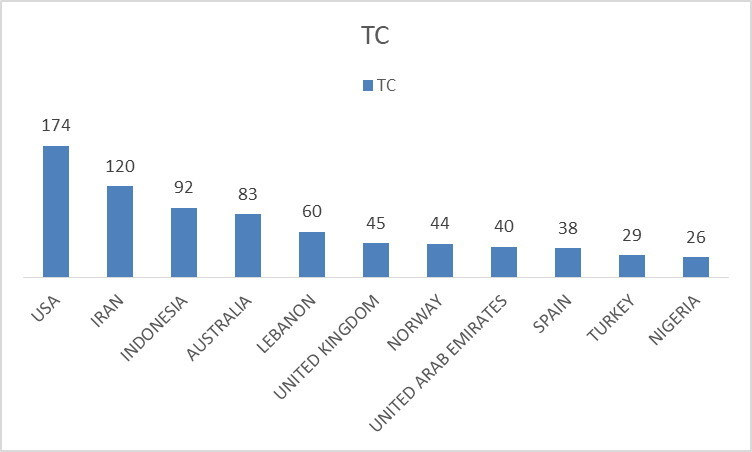
Figure 3 Country Wise Article Citations
This line graph shows the average article citations per country. The x-axis of the graph lists the countries, but some labels are cut off. The y-axis shows the average number of citations, likely ranging from 0 to 200. There seems to be a significant disparity in the average number of citations across countries. Some countries, like the United States (USA) and Canada, appear to have a higher average number of citations than others, like Thailand and Ecuador. Several factors can influence how often a research article is cited, including the field of study, the reputation of the journal in which it’s published, and the overall quality and impact of the research. Countries with strong research institutions and a focus on innovation might tend to have higher average citations.

Figure 4 Country Scientific Production
The countries highlighted in dark blue color on the map have conducted more research in the field of reading comprehension and critical thinking skills. These countries include the United States of America, Canada, several European nations like the United Kingdom, Germany, France, and Italy, as well as India and Australia. The map visually represents the geographical distribution of research activities related to these two crucial academic skills, with the darker shades indicating higher concentration or frequency of studies in those regions.
A. Visualization of Keywords using Vos Viewer
VOS viewer provides a systematic approach to understanding the structure and dynamics of scholarly communication, aiding in the synthesis of knowledge and the identification of future research directions. Identifying Key Themes and Relationships, Mapping Co-occurrence Networks, Cluster Analysis, and Interpretation based on those mapping is done and presented in Fig 5 (Network Visualization); Fig 6 (Overlay Visualization) and Fig 7 (Density Visualization).
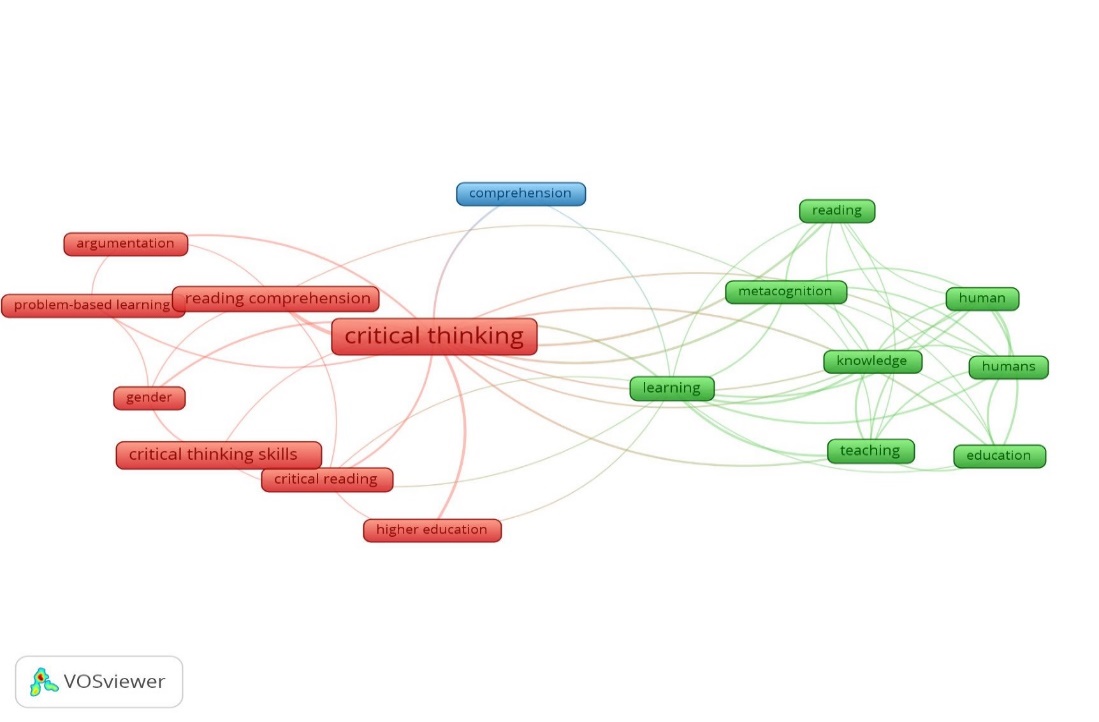
Figure 5 Network Visualization
|
Clusters |
Keywords |
|
Cluster 1 (Red color) |
Argumentation comprehension critical reading, critical thinking, critical thinking skills, gender, higher education, problem-based learning, reading comprehension |
|
Cluster 2 (Green Color) |
Education, human, knowledge, learning, metacognition, reading, teaching |
|
Cluster 3 (Blue) |
Comprehension |
The diagram depicts the central concept of "critical thinking skills" represented by a green circle, with related concepts surrounding it. Key relationships illustrated include critical thinking skills being a component of critical reading, used in argumentation, developed through problem-based learning, and associated with metacognition. Additionally, the diagram suggests that critical thinking skills are interconnected with knowledge, education, teaching, and learning. Though terms like "reading comprehension," "gender," and "higher education" are present without direct connection to critical thinking skills, they likely relate to the broader context of education.
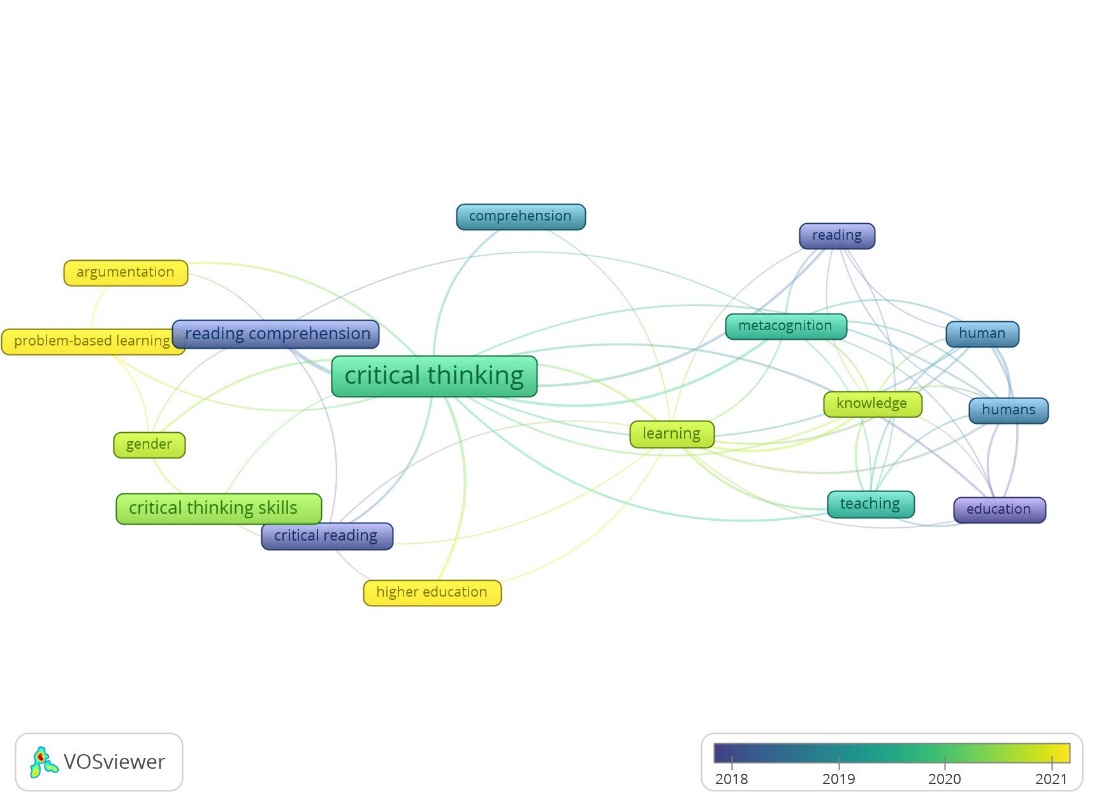
Figure 6 Overlay Visualization
The date ranges from 2017.0 to 2018.5 shown at the bottom of the diagram suggests a timeline or period over which research or data related to the concepts presented was majorly collected or analyzed at the maximum. It indicates how the research focus, importance, or emphasis on the various concepts have evolved or changed over time. From fig 3 we can evidently see that the focus has been shifted from critical reading to problem solving skills. The concept of "reading comprehension" remains central and consistently relevant, however the consistent presence of comprehension as a core component suggests that comprehension skills is recognized as a crucial element in the development and application of critical thinking during this period.
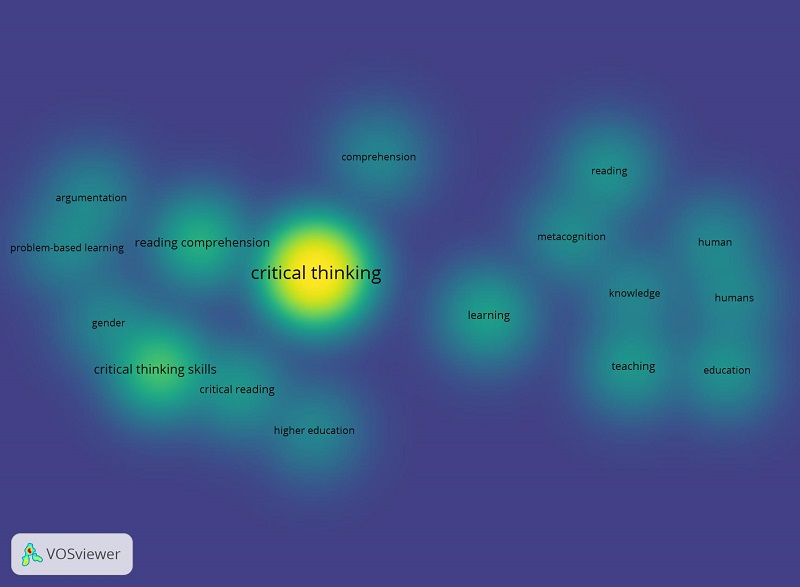
Figure 7 Density Visualization
The different colors and intensities suggest the relative importance, emphasis, or focus placed on each concept during the study or analysis. The brightest yellow region seems to be centered around "critical thinking," indicating that this concept received the highest level of attention or priority. This suggests that developing critical thinking skills was a key area of emphasis in the research or educational context depicted by the diagram. Surrounding the "critical thinking" core, the shades transition to a bright green, encompassing concepts like "reading comprehension" and "critical thinking skills." This implies that these concepts were also given significant importance, likely as essential components or prerequisites for fostering critical thinking abilities. As the nodes move further away from the center, their intensity decreases, implying a lesser direct connection to the core concept of critical thinking. These nodes include "gender", "higher education", "comprehension", "reading", "metacognition", "human", "humans", "knowledge", "learning", "teaching", and "education". Here too we find comprehension has not been majorly studied in reference to these cognitive skills.
IV. FINDINGS
From 1986 to 2024, there has been a noticeable surge in the publication of articles pertaining to comprehension, particularly evident in the United States, underscoring a growing interest in this field. Analysis also reveals a stark contrast in citation rates among countries, with the United States and Canada leading, signaling regional disparities in research impact. Central to educational measurement and assessment, critical thinking skills emerge as promising, alongside related concepts such as critical reading and problem-solving. While research focus has shifted towards problem-solving skills, reading comprehension remains consistently relevant. However, despite its importance, comprehension has received limited attention in relation to critical thinking skills, suggesting avenues for further exploration. These findings collectively underscore the evolving landscape of research in reading comprehension and emphasize the crucial role of critical thinking skills, pointing towards potential areas for future investigation
V. DISCUSSION
The research highlights a key gap in understanding how to effectively develop both critical thinking and reading comprehension skills, especially for English as Second Language (ESL/EFL) learners. When individuals engage in reading, they take on an active role in interacting with the writer's text by employing various strategies such as predicting, analyzing, summarizing, and utilizing other reading techniques which aligns with the earlier findings of (Ali and Razali). Most studies focus on either critical thinking or reading comprehension separately, with minimal exploration of combining them in ESL/EFL contexts. The educational system now faces greater responsibility in ensuring a conducive and fruitful learning environment where both life skills and academic abilities are imparted and nurtured.(Moghadam et al.) Existing research often overlooks the unique needs of adult ESL/EFL learners in higher education. Similarly, the role of factors like language proficiency, cultural background, and learning preferences in skill development needs further investigation.(Gharbavi and Mousavi) While qualitative research exists, more in-depth studies are needed to understand learners' experiences and challenges. A need for research on student-created vs. teacher-led questioning, technology integration for questioning, and combining questioning with other active learning techniques is required since most students experienced a significant improvement in their critical thinking dispositions through the use of questioning, they displayed more positive attitudes towards teacher-led questioning tasks compared to student-created questioning tasks.(Hou) More research is needed on questioning strategies specifically for analyzing and comprehending literature, given the significance of questioning as a high-level cognitive strategy in language teaching and learning in the literature on TEFL as well as in education in general.(Davoudi and Sadeghi) There's a gap in research on innovative digital platforms specifically designed to facilitate critical reading of texts, as researches state that Cirrus's annotation tools facilitate teachers in guiding students towards close critical engagements with diverse materials, including text, images, audio, and video formats, while their exhibition-building software enables the conversion of traditional essays into comprehensive online presentations integrating various resources like words and images.(Kilner et al.) Studies tracking the long-term impacts of interventions on critical thinking and reading comprehension abilities are limited. Research on the role of motivation, self-efficacy, and other emotional factors influencing critical reading development is lacking, as students in developmental reading courses exhibit lower self-efficacy levels compared to those in credit-bearing English courses, with mastery experiences playing a significant role in influencing reading self-confidence.(Cantrell et al.) Hence, we can see there's a critical need for research that explores effective pedagogical approaches, materials, and interventions that seamlessly integrate critical thinking and reading comprehension development for ESL/EFL learners, particularly in higher education settings.
VI. LIMITATIONS
The study focused exclusively on literature published in English, thereby potentially excluding valuable insights from other languages. The records and studies taken for analysis were only among the publications found in the Scopus database.
Conclusion
The analysis emphasizes critical thinking skills overall, but it doesn\'t explicitly highlight one comprehension skill as the most prominent. However, we can make some inferences such as Critical Reading might be a strong contender: Since critical thinking is central and critical reading is directly connected to it, there\'s a strong chance critical reading comprehension is a standout skill. Critical reading involves understanding the nuances of text, identifying arguments, and evaluating evidence, which all directly feed into critical thinking. The link between critical thinking and problem-based learning suggests that comprehending problems effectively is another key skill. This involves grasping the core issue, identifying relevant information, and considering different solutions – all essential aspects of critical thinking. It\'s important to remember that the specific comprehension skill that stands out might depend on the context. For example, in a research setting, scientific comprehension might be crucial, while in a debate, comprehending opposing viewpoints would be key. The conducted bibliometric analysis thus highlights the importance of strong comprehension skills in general, particularly those related to critical reading and problem-solving, as building blocks for critical thinking.
References
[1] Ali, Aziza M., and Abu Bakar Razali. “A Review of Studies on Cognitive and Metacognitive Reading Strategies in Teaching Reading Comprehension for ESL/EFL Learners.” English Language Teaching, vol. 12, no. 6, 2019, https://doi.org/10.5539/elt.v12n6p94. [2] Almulla, Mohammed Abdullatif, and Waleed Mugahed Al-Rahmi. “Integrated Social Cognitive Theory with Learning Input Factors: The Effects of Problem-Solving Skills and Critical Thinking Skills on Learning Performance Sustainability.” Sustainability (Switzerland), vol. 15, no. 5, 2023, https://doi.org/10.3390/su15053978. [3] Aria, Massimo, and Corrado Cuccurullo. “Bibliometrix : An R-Tool for Comprehensive Science Mapping Analysis.” Journal of Informetrics, vol. 11, no. 4, Nov. 2017, pp. 959–975, https://doi.org/10.1016/j.joi.2017.08.007. [4] Cantrell, Susan Chambers, et al. “Patterns of Self-Efficacy among College Students in Developmental Reading.” Journal of College Reading and Learning, vol. 44, no. 1, 2013, https://doi.org/10.1080/10790195.2013.10850370. [5] Davoudi, Mohammad, and Narges Amel Sadeghi. “A Systematic Review of Research on Questioning as a High-Level Cognitive Strategy.” English Language Teaching, vol. 8, no. 10, 2015, https://doi.org/10.5539/elt.v8n10p76. [6] Donthu, Naveen, et al. “How to Conduct a Bibliometric Analysis: An Overview and Guidelines.” Journal of Business Research, vol. 133, no. 133, Sept. 2021, pp. 285–96, https://doi.org/10.1016/j.jbusres.2021.04.070. [7] Farley, Mary Jane, and Patricia B. Elmore. “The Relationship of Reading Comprehension to Critical Thinking Skills, Cognitive Ability, and Vocabulary for a Sample of Underachieving College Freshmen.” Educational and Psychological Measurement, vol. 52, no. 4, 1992, https://doi.org/10.1177/0013164492052004014. [8] Gharbavi, Abdullah, and Seyyed Ahmad Mousavi. “Do Language Proficiency Levels Correspond to Language Learning Strategy Adoption?” English Language Teaching, vol. 5, no. 7, 2012, https://doi.org/10.5539/elt.v5n7p110. [9] Hou, Yen ju. “Employing Questioning to Cultivate Critical Thinking Dispositions and Attitudes toward Questioning: A Case Study with Taiwanese EFL Students.” International Journal of Pedagogy and Curriculum, vol. 26, no. 2, 2019, https://doi.org/10.18848/2327-7963/CGP/v26i02/1-18. [10] Kilner, Kerry, et al. “Using Innovative Teaching Practices to Inspire Critically Engaged Reading and Writing in a Neoliberal University Environment.” Higher Education Research and Development, vol. 38, no. 1, 2019, https://doi.org/10.1080/07294360.2018.1537258. [11] Moghadam, Zahra Bakhtiari, et al. “The Effect of Implementing a Critical Thinking Intervention Program on English Language Learners’ Critical Thinking, Reading Comprehension, and Classroom Climate.” Asian-Pacific Journal of Second and Foreign Language Education, vol. 8, no. 1, 2023, https://doi.org/10.1186/s40862-023-00188-3. [12] Murali, R., and K. Mohamed Jasim. “Biblometric Analysis on Agritech and Agribusiness Management - Present Achievement of Agri Tech in India and Future Research Agenda.” The Management Accountant Journal, vol. 57, no. 5, 1 May 2022, p. 71, https://doi.org/10.33516/maj.v57i5.71-76p. Accessed 1 Sept. 2022. [13] Page, Matthew J., et al. “The PRISMA 2020 Statement: An Updated Guideline for Reporting Systematic Reviews.” The BMJ, vol. 372, 2021, https://doi.org/10.1136/bmj.n71. [14] Van Eck, Nees Jan, and Ludo Waltman. “VOSviwer Manual Version 1.6.10.” CWTS Meaningful Metrics, no. January, 2019. [15] Zepke, Nick, and Linda Leach. “Improving Student Engagement: Ten Proposals for Action.” Active Learning in Higher Education, vol. 11, no. 3, 2010, https://doi.org/10.1177/1469787410379680.
Copyright
Copyright © 2024 Sahaya Restina James, Dr. K Selvam. This is an open access article distributed under the Creative Commons Attribution License, which permits unrestricted use, distribution, and reproduction in any medium, provided the original work is properly cited.

Download Paper
Paper Id : IJRASET64271
Publish Date : 2024-09-19
ISSN : 2321-9653
Publisher Name : IJRASET
DOI Link : Click Here
 Submit Paper Online
Submit Paper Online

